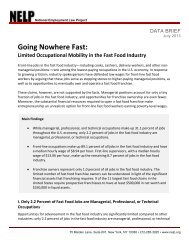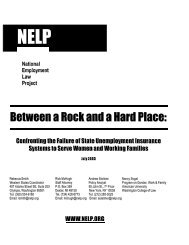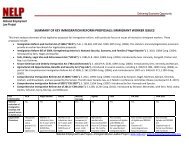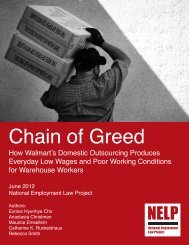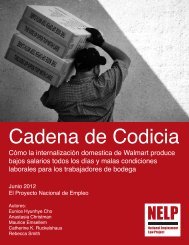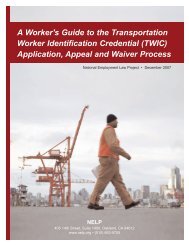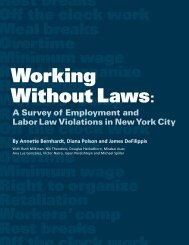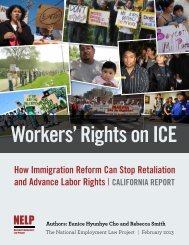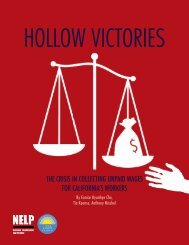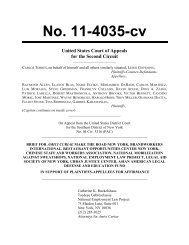Rebuilding Lives. Strengthening Communities.
Rebuilding Lives. Strengthening Communities.
Rebuilding Lives. Strengthening Communities.
Create successful ePaper yourself
Turn your PDF publications into a flip-book with our unique Google optimized e-Paper software.
Chapter 3: Family (cont.)<br />
58<br />
United States Senate. 2000. Departments of Commerce, Justice and the State, the Judiciary and Related Agencies Appropriation Bill.<br />
106th Congress. Senate Report 106-404. This Senate Report indicates that “children of prisoners are six times more likely than other<br />
children to be incarcerated at some point in their lives.” Quoted in “Services for Families of Prison Inmates,” Special Issues in<br />
Corrections, U.S. Department of Justice, National Institute of Corrections (February 2002),<br />
http://www.nicic.org/pubs/2002/017272.pdf (accessed November 5, 2005).<br />
59<br />
Big Brothers and Big Sisters of Metropolitan Chicago, “Our Program Works!” http://www.bbbschgo.org/program.html (accessed August<br />
12, 2005).<br />
60<br />
In the 2003 State of the Union Address, President Bush talks about $450 million for mentoring programs; one-third of that money was<br />
intended for children of prisoners. Bush, George W., “2003 State of the Union Address” (speech, United States Capitol, Washington<br />
D.C., January 28, 2003), http://www.whitehouse.gov/news/releases/2003/01/20030128-19.html (accessed July 18, 2005).<br />
61<br />
For more information about the funding opportunity through the Mentoring Children of Prisoners Initiative, see the U.S. Department<br />
of Health & Human Services, Administration for Children and Families website, http://www.acf.hhs.gov/grants/open/HHS-2004-ACF-<br />
ACYF-CU-0001.html.<br />
62<br />
The Mentoring Center website, “About Us” http://www.mentor.org/about_us.html and The Child Welfare League of America website,<br />
“Main Page” http://www.cwla.org/programs/incarcerated/<br />
63<br />
See, for instance, Newby, Gretchen and Nell Bernstein, “Children of Incarcerated Parents: A Bill of Rights” (San Francisco, CA: San<br />
Francisco Partnership for Incarcerated Parents, 2003) which sets forth eight rights that should be recognized on behalf of children of<br />
incarcerated parents.<br />
64<br />
Goode, W. Wilson Jr. and Thomas J. Smith, “Building From the Ground Up: Creating Effective Programs to Mentor Children of Prison;<br />
The Amachi Model” (Philadelphia, PA: Public/Private Ventures, July 2005), http://www.ppv.org/ppv/publications/assets/<br />
185_publication/pdf (accessed November 14, 2005).<br />
Chapter 4: Community Safety<br />
1<br />
We recognize that “community” is often determined by geographic area. But, viewed broadly, it is not defined solely by street corners<br />
and lines on a map. It consists of people as much as brick and mortar. It is made up of neighbors, colleagues, family, friends, clergy,<br />
associations, organizations, businesses, institutions that form a loose social network. For us, in the context of reentry, we think<br />
“community” is best viewed as the collection of people who are most affected by and most influential in an individual’s return from<br />
prison. Community, therefore, is fluid and relative to the formerly incarcerated individual. We are viewing community as those people<br />
who have the ability and means to directly impact the returning prisoner, who can be impacted by the returning prisoner, who have a<br />
clear stake and vested interest in the outcome.<br />
2<br />
Visher, Christy, and Jill Farrell, “Chicago <strong>Communities</strong> and Prisoner Reentry,” (Washington, D.C.: The Urban Institute, 2005), 1.<br />
3<br />
La Vigne, Nancy G. and Cynthia A. Mamalian, “A Portrait of Prisoner Reentry in Illinois,” (Washington, D.C.: The Urban Institute, 2003), 46.<br />
4<br />
La Vigne, Nancy G. and Cynthia A. Mamalian, “A Portrait of Prisoner Reentry in Illinois,” (Washington, D.C.: The Urban Institute, 2003), 46.<br />
5<br />
La Vigne, Nancy G. and Cynthia A. Mamalian, “A Portrait of Prisoner Reentry in Illinois,” (Washington, D.C.: The Urban Institute, 2003), 46.<br />
6<br />
Unpublished data provided by Steven Karr (Manager, Planning and Research Unit, Illinois Department of Corrections).<br />
7<br />
La Vigne, Nancy G. and Cynthia A. Mamalian, “A Portrait of Prisoner Reentry in Illinois,” (Washington, D.C.: The Urban Institute, 2003), 51.<br />
8<br />
“Prisoner Reentry and Community Policing: Strategies for Enhancing Public Safety” (working paper from the Urban Institute Reentry<br />
Roundtable Meeting, May 12-13, 2004), 5.<br />
9<br />
Visher, Christy, and Jill Farrell, “Chicago <strong>Communities</strong> and Prisoner Reentry,” (Washington, D.C.: The Urban Institute, 2005), 2-3.<br />
10<br />
Mary Pattillo and others, eds., Imprisoning America: The Social Effects of Mass Incarceration (New York, NY: Russell Sage Foundation,<br />
2004), 139.<br />
11<br />
U.S. Department of Justice, “Illinois Going Home Program Abstract,” http://www.ojp.usdoj.gov/reentry/sar/pdf/wp1_il.pdf (accessed<br />
July 12, 2005).<br />
12<br />
Christine Rothwell (Program Director, Illinois Going Home Program), interview with Julie Wilen, October 28, 2005.<br />
13<br />
Christine Rothwell (Program Director, Illinois Going Home Program), interview with Julie Wilen, October 28, 2005.<br />
14<br />
Christine Rothwell (Program Director, Illinois Going Home Program), interview with Julie Wilen, October 28, 2005.<br />
15<br />
The likelihood of rearrest is highest during the period immediately following release—30 percent of arrests occur within six months of<br />
release, 14 percent occur within 6-12 months after release, 15 percent occur 12-24 months after release, and eight percent occur 24-36<br />
months after release. See “Prisoner Reentry and Community Policing: Strategies for Enhancing Public Safety” (working paper from the<br />
Urban Institute, Reentry Roundtable Meeting, May 12-13, 2004), 5.<br />
16<br />
Petersilia, Joan, When Prisoners Come Home: Parole and Prisoner Reentry (New York, NY: Oxford University Press, 2003), 196.<br />
17<br />
La Vigne, Nancy G. and Christine Visher, “Chicago Prisoners’ Experiences Returning Home” (Washington, D.C.: The Urban Institute,<br />
December 2004), 3.<br />
18<br />
Richard Guzman (Manager, Office of Reentry Management and Placement Resource Unit, Illinois Department of Corrections), interview<br />
with Ben Lumpkin, April 28, 2005.<br />
19<br />
Richard Guzman (Manager, Office of Reentry Management and Placement Resource Unit, Illinois Department of Corrections), interview<br />
with Ben Lumpkin, April 28, 2005.<br />
MAYORAL POLICY CAUCUS ON PRISONER REENTRY<br />
125





